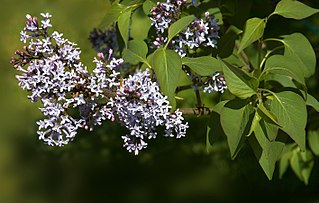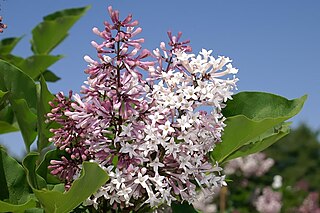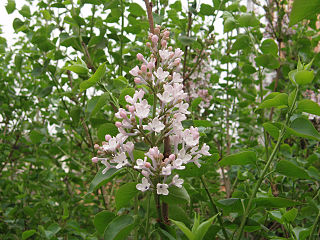
Syringa is a genus of 12 currently recognized species of flowering woody plants in the olive family or Oleaceae called lilacs. These lilacs are native to woodland and scrub from southeastern Europe to eastern Asia, and widely and commonly cultivated in temperate areas elsewhere.

Philadelphus (mock-orange) is a genus of about 60 species of shrubs from 3–20 ft tall, native to North America, Central America, Asia and (locally) in southeast Europe.

Malus is a genus of about 32–57 species of small deciduous trees or shrubs in the family Rosaceae, including the domesticated orchard apple, crab apples and wild apples.

Mahonia is a formerly accepted genus of approximately 70 species of shrubs or, rarely, small trees with evergreen leaves in the family Berberidaceae, native to eastern Asia, the Himalaya, North America, and Central America. They are closely related to the genus Berberis and as of 2023 the majority of botanical sources list it as a synonym for Berberis.

Dasiphora fruticosa is a species of hardy deciduous flowering shrub in the family Rosaceae, native to the cool temperate and subarctic regions of the northern hemisphere, often growing at high altitudes in mountains. Dasiphora fruticosa is still widely referenced in the horticultural literature under its synonym Potentilla fruticosa. Common names include shrubby cinquefoil, golden hardhack, bush cinquefoil, shrubby five-finger, widdy, kuril tea and tundra rose.

Rhamnus is a genus of about 140 accepted species of shrubs or small trees, commonly known as buckthorns, in the family Rhamnaceae. Its species range from 1 to 10 m tall and are native mainly in east Asia and North America, but found throughout the temperate and subtropical Northern Hemisphere, and also more locally in the subtropical Southern Hemisphere in parts of Africa and South America. One species, the common buckthorn, is able to flourish as an invasive plant in parts of Canada and the United States, where it has become naturalized.

Syringa vulgaris, the lilac or common lilac, is a species of flowering plant in the olive family, Oleaceae. Native to the Balkan Peninsula, it is widely cultivated for its scented flowers in Europe and North America.

Mentha longifolia, also known as horse mint, brookmint, fillymint or St. John's horsemint, is a species of plant in the family Lamiaceae. It is native to Europe excluding Britain and Ireland, western and central Asia, and northern and southern Africa.

Syringa komarowii is a species of lilac native to central China, commonly called nodding lilac. It is native to the Provinces of Gansu, Hubei, Shaanxi, Sichuan, Yunnan.

Syringa × laciniata, the cut-leaf lilac or cutleaf lilac, is a hybrid lilac of unknown, though old origin. It is thought to be a hybrid between Syringa vulgaris from southeastern Europe and Syringa protolaciniata from western China. Although often cited as being from China, it more likely arose somewhere in southwestern Asia, where it was first scientifically described from cultivated plants in the 17th century, possibly Iran or Afghanistan, or Pakistan, where it has been cultivated since ancient times.

Salix integra is a species of willow native to north-eastern China, Japan, Korea and the far south-eastern Russia.

Syringa josikaea, the Hungarian lilac, or Lady Josika's lilac is a species of lilac in the olive family Oleaceae, native to central and eastern Europe, in the Carpathian Mountains in Romania and western Ukraine. A large shrub, it has a very restricted range, although fossils assigned to the species suggest a much wider prehistoric distribution in central Europe. Today it is threatened in the wild by habitat destruction, but is also commonly used in gardening.

Syringa reticulata, the Japanese tree lilac, is a species of flowering plant in the family Oleaceae. It is native to eastern Asia, and is grown as an ornamental in Europe and North America.

Syringa pubescens is a species of flowering plant in the lilac genus of the family Oleaceae, native to Korea and China.

The Miss Kim lilac is a cultivar of lilac which was selected by Elwyn M. Meader while stationed in Korea as an army horticulturist. It was supposedly named after Elwyn M. Meader's Korean helper, whose name was Kim. The species is endemic to Korea and Northeast China. Flowers produced by this species are of pink, purple, and a light blue hues which accompany a sweet smelling aroma. Alongside flower production fruits called loculicidal capsules are produced. This species tends to bloom in the spring months.

Syringa oblata is a species in the genus Syringa, in the family Oleaceae. It is also known as early blooming lilac or broadleaf lilac.

Syringa oblatasubsp.dilatata, also known as Korean early lilac, is a subspecies of the species Syringa oblata in the genus Syringa, in the family Oleaceae.
Syringa reticulatasubsp.pekinensis, also known as the Pekin lilac or the Chinese tree lilac, grows in an open, multi-stemmed form to a height of 15 to 20 feet, with a spread of 10 to 15 feet. They are native to northern China but grow in USDA hardiness zones 3 through 7. It is grown as an ornamental tree in Europe and North America.

Syringa pinnatifolia, the pinnate lilac, is a deciduous shrub in the genus Syringa, in the family Oleaceae. It is native to Western China.
Syringa × diversifolia, commonly known as the varyleaf lilac, is a hybrid shrub of the genus Syringa.



















